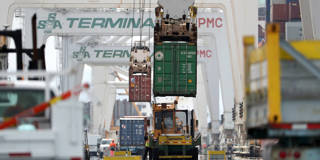Given the growth in global trade over the past few years, it may be tempting to argue that geopolitically motivated trade barriers have had a negligible economic impact. But while the international trading system may appear resilient, tariffs and other restrictive measures carry significant costs.
BRUSSELS – The emergence of an open multilateral trading system that separated trade from geopolitics played a pivotal role in driving the post-World War II economy. But with trade policies increasingly shaped by geopolitical considerations, a new paradigm is becoming visible.
This trend started with the tariffs that former US President Donald Trump imposed on Chinese imports in 2018, which President Joe Biden’s administration has maintained, and which caused China to impose its own tariffs on imports from the United States. Then, in 2022, following Russian President Vladimir Putin’s invasion of Ukraine, G7 countries and the European Union imposed sweeping economic sanctions on Russia, effectively prohibiting exports to Russia and imports of Russian goods.
Instead of causing global trade to fall, as many expected, these trade barriers and restrictive measures merely slowed down globalization, turning it into “slowbalization.” Remarkably, despite the war in Ukraine and the supply-chain disruptions of the past few years, trade as a percentage of GDP reached a record high in 2022, underscoring the resilience of the international trading system. In fact, the increases in container-shipment prices since 2022 can be attributed to an unexpected surge in the volume of goods being shipped globally.

BRUSSELS – The emergence of an open multilateral trading system that separated trade from geopolitics played a pivotal role in driving the post-World War II economy. But with trade policies increasingly shaped by geopolitical considerations, a new paradigm is becoming visible.
This trend started with the tariffs that former US President Donald Trump imposed on Chinese imports in 2018, which President Joe Biden’s administration has maintained, and which caused China to impose its own tariffs on imports from the United States. Then, in 2022, following Russian President Vladimir Putin’s invasion of Ukraine, G7 countries and the European Union imposed sweeping economic sanctions on Russia, effectively prohibiting exports to Russia and imports of Russian goods.
Instead of causing global trade to fall, as many expected, these trade barriers and restrictive measures merely slowed down globalization, turning it into “slowbalization.” Remarkably, despite the war in Ukraine and the supply-chain disruptions of the past few years, trade as a percentage of GDP reached a record high in 2022, underscoring the resilience of the international trading system. In fact, the increases in container-shipment prices since 2022 can be attributed to an unexpected surge in the volume of goods being shipped globally.